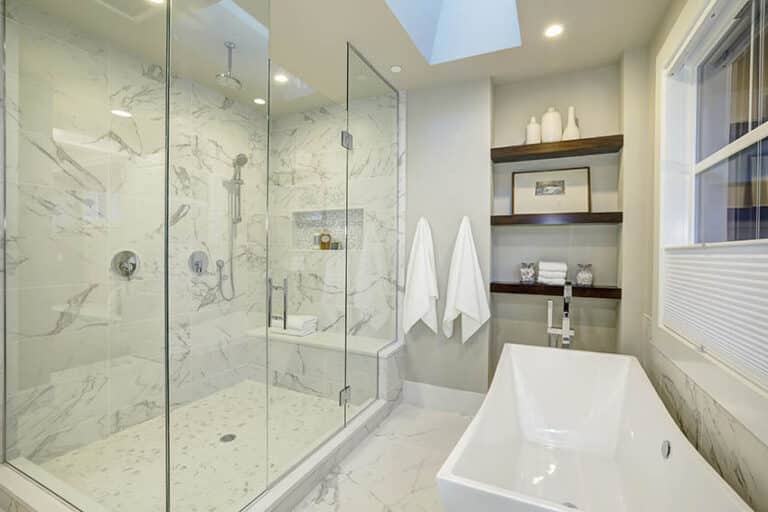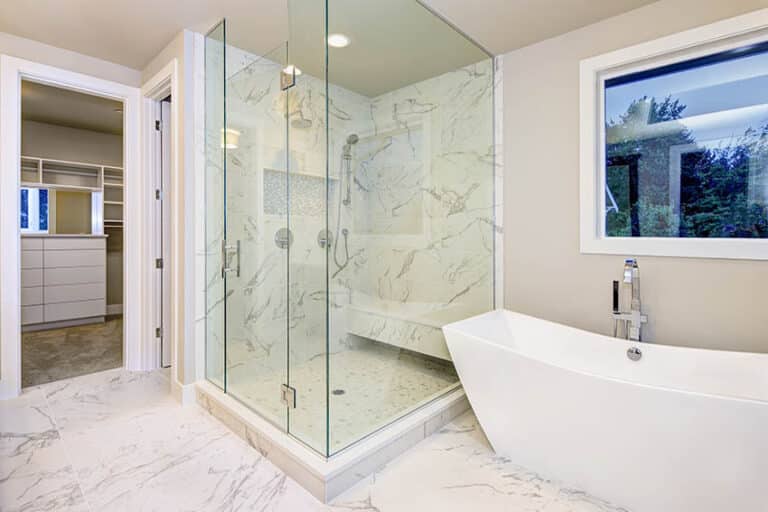5 Perfect Patterns For Farmhouse Shower Tile Ideas (Designer Tips)
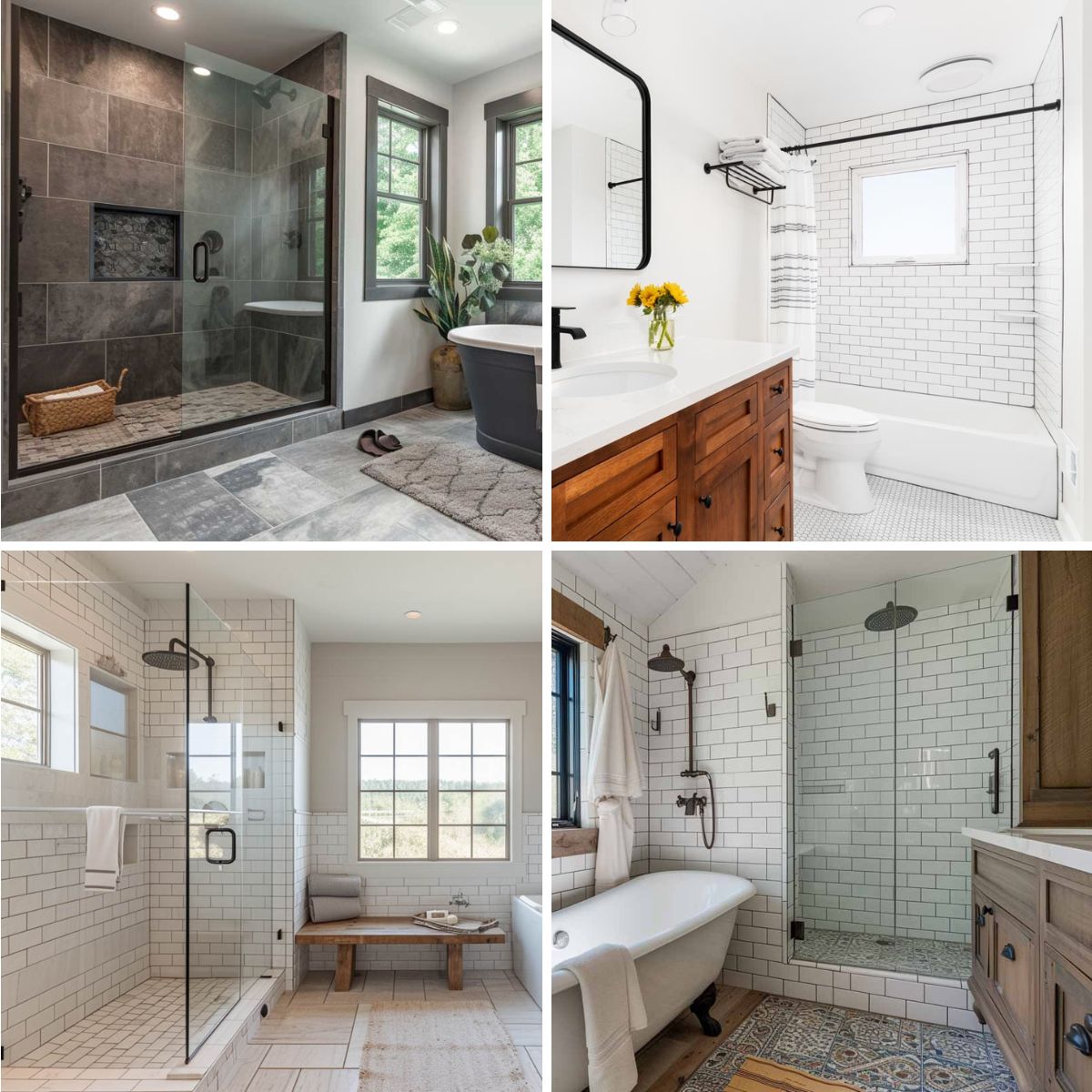
When it comes to creating an inviting environment in the bathroom, few options capture the essence of rustic charm, like farmhouse shower tile. With its welcoming aesthetics, farmhouse-inspired elements can transform a dull shower into a cozy retreat. There are many ideas that can be considered for your shower space to give you the farmhouse feel you want.
Choosing A Farmhouse Style For Your Shower
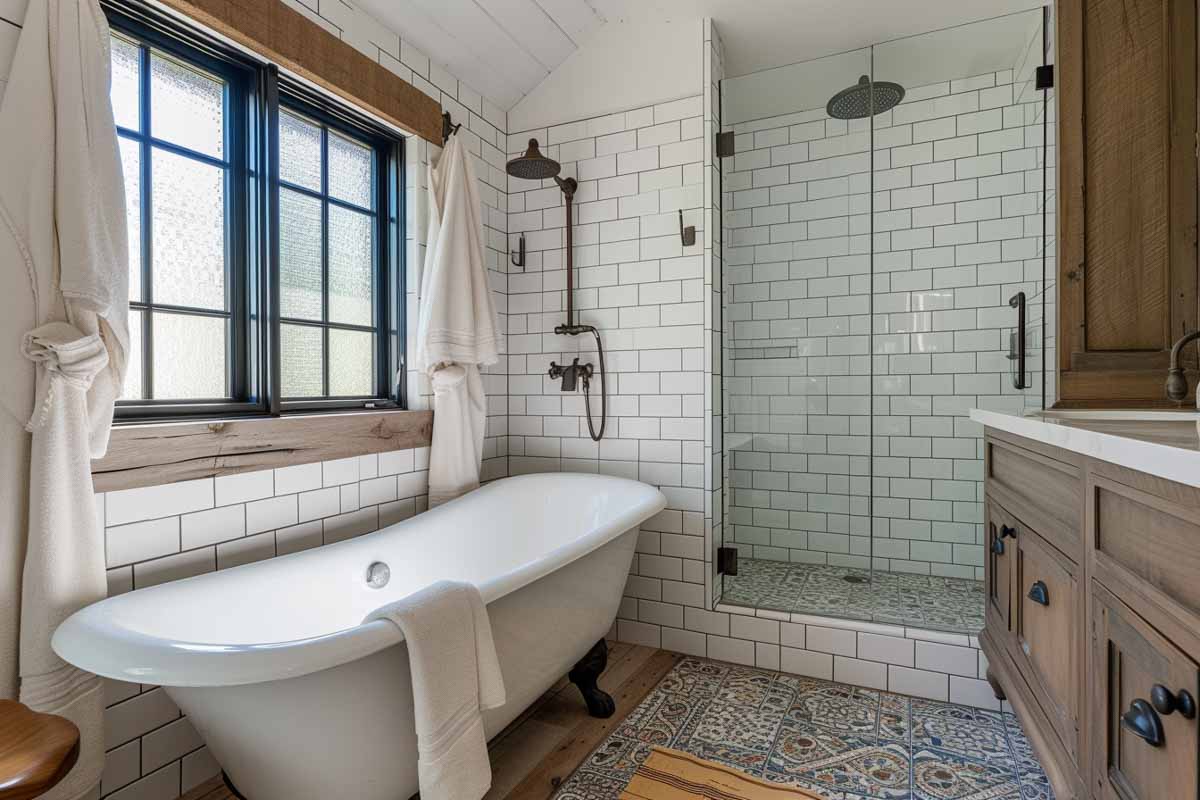
Selecting the right farmhouse style for your shower should reflect your taste and lifestyle, and there are great options to choose from to create that perfect cozy and homely ambiance.
Designer Tips
An organic and natural look: To capture the essence of the farmhouse style in the bathroom, use neutral tones found in nature. Soft beige, muted tones, warm whites, and any color tone found in nature.
Simple and Timeless Shapes: The basic square or hexagon is an opportunity to add farmhouse patterns or stay with the classic herringbone or chevron shapes.
Familiar Farmhouse Patterns: Patterns can spruce up plain bathroom showers, and these can either be in a full shower surround or act as accents. Soft-tinged florals or fern mosaic patterns are perfect for creating that vintage farmhouse style.
Select from Fresh and Vintage Color Palettes: Take inspiration from your traditional farmhouse, such as subdued and neutral tones. Newer tones from 2023 and next year include warm undertones with options of having deep blues and greens as well as terracotta tones.
Select an impervious tile: All the finishes in a shower, including the floor and wall area, are subject to water and moisture damage. Select a type of wall tile that can handle constant exposure to water and does not allow water seepage through the substrate.
Glass, porcelain, and sealed natural stone tiles are some examples of waterproof finishes, with porcelain as the most cost-effective solution with many design options to choose from. You could also get a porcelain tile that looks like natural wood or stone.
Balance budget and quality: From bargain tiles to luxury tiles, you’ll find a wide price range of tiles today. A ceramic tile is a great option if you’re looking to spend around $200 to $400 for a complete shower surround.
Entry-level porcelain tiles are also a great option that ranges from $3 to $10 per square foot. For an impervious surface that’s relatively new, you can check for a stylish glass tile shower that typically ranges from $8 to $30 per square foot.
Higher quality, such as marble and other natural stones, include granite and marble that range from $12 to $50. But with natural stones, you’ll need to account for the needed sealant for the floor or wall surface, especially marble, as it is a porous stone. Exotic, rare, and custom or artistic tiles, on the other hand, can cost you around $150 per square foot.
Ensure Cohesiveness Among Elements: It’s easier to choose design elements for your bathroom, such as hardware, fixtures, substrates, and finishes for new construction.
However, it’s more challenging to match your farmhouse tiles to your existing elements. You can use free shower 3D simulation software provided by your supplier to check how the tiles look before actually installing your wall finish.
Other Factors to Consider:
• You can handle the maintenance and cleaning.
• The farmhouse shower tiles meet your style and visual taste.
• Readily available in your local area. If not, consider the shipping or transportation costs.
Materials and Finishes
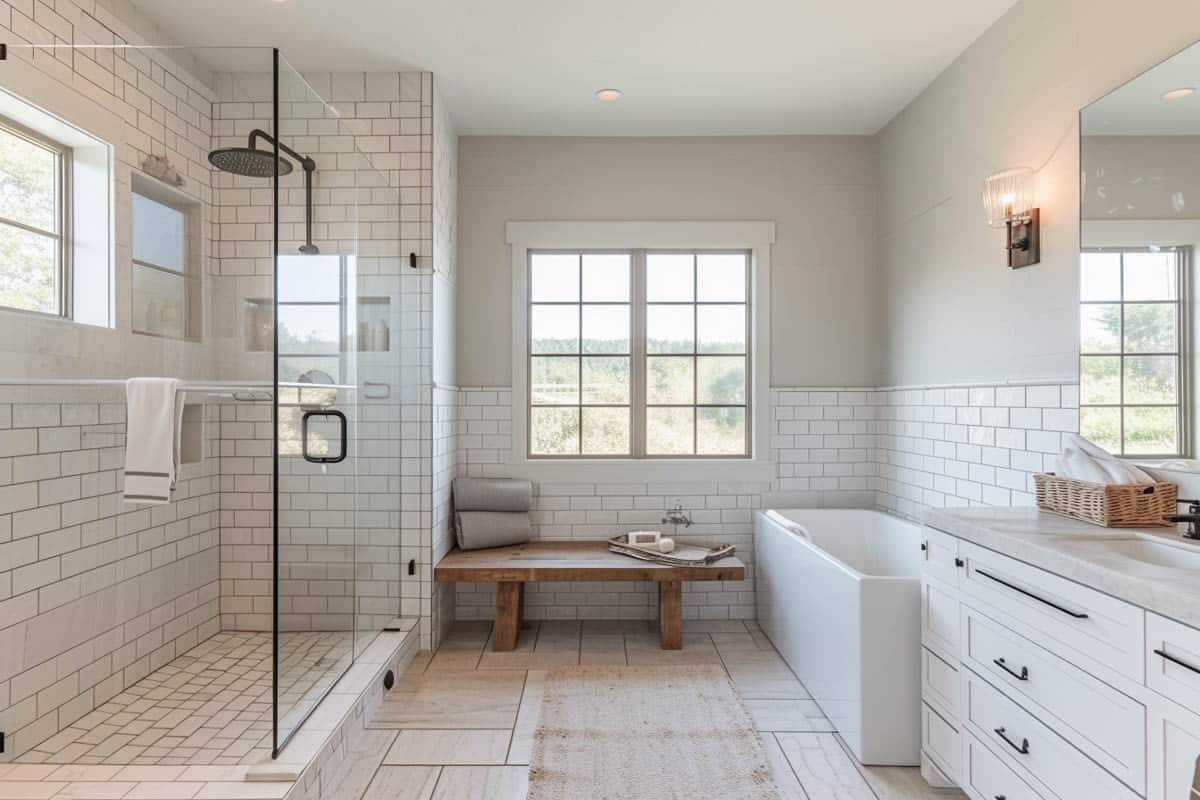
Generally, you’ll have matte, polished, glazed or textured when it comes to tiles. Choose the finish based on the tile material you choose. For instance, for subway tiles, a matte or glazed finish is a perfect option, while herringbone pattern tiles are great with matte as well as a glazed finish.
Subway Tile Patterns for a Classic Farmhouse Look: Subway tile patterns are the most identifiable farmhouse tile layout, where their simplicity and ease of matching with other farmhouse elements make them a time-enduring wall finish.
Subway tile, or simple rectangular tile, blends the shower into its surroundings. – Made for Living: Collected Interiors for All Sorts of Styles, Amber Lewis, Cat Chen
Typically, the subway tiles are in white or light-colored tones with narrow grout lines to match contemporary versions of the farmhouse.
There are several types of subway tile patterns.
• Stack Bond – For that Modern Farmhouse: The simplest and most known subway layout with a grid-type composition. Tiles are laid out horizontally parallel to each other. However, this can be more challenging to install since misalignment can be noticeable. You’ll need a skilled tiler to ensure a level of the surface as well as the space between tiles.
• Running Bond – The Iconic Subway Tile: The running bond is perfect for having that traditional feel of a farmhouse shower surround. Running bond has an offset of around two-thirds of the tile. The layout is positioned horizontally to create that.
• Vertical Running Bond – A 90-degree Twist to the Classic Subway Tiles: A variation of running bond, this layout has the longer sides laid out in an upright position and where the succeeding tiles are offset around two-thirds of the longer tile is used.
Hexagon Tile Designs for a Vintage Farmhouse Vibe: Inspired by nature, the hexagon tile is the perfect farmhouse tile that can effortlessly give that classic foundation while having that modern farmhouse plan vibe. The six-sided tile is great for small shower areas where you can envelop its two-thirds height or create a focal wall so as not to overwhelm the space.
Herringbone and Chevron Patterns for Modern Farmhouse Appeal: The basketweave tile pattern herringbone exudes a cozy atmosphere. If you plan to have a plain and neutral-toned tile finish, the herringbone is the perfect pattern to add dimension and richness to the shower space. The chevron also creates movement and richness to the shower’s wall.
The pattern has many claims of its origins, from the Roman parquet pattern inspired by brick arrangement to the Greeks’ resemblance to the layout as two adjoining beams. But the V-pattern resembles elements found in nature, such as migrating birds, water currents, mountains, foliage, and even natural markings found in animals. The chevron tile is a perfect alternative when you want to break from the typical farmhouse tile patterns.
Connor Prestwood, an interior designer at home décor brand Dowsing & Reynolds, shared insights saying, “Modern farmhouse style is becoming more and more popular, especially in bath and shower rooms. Its authentic charm and character really compels us to relax and be at one with ourselves when in these spaces.”
Adding Texture with Moroccan or Encaustic Tiles: Fire-baked tiles are known to be durable and won’t have infused pigments that make them hard-wearing. In addition, you don’t have to worry about stains seeping through your shower tiles. The two most popular heated tiles for farmhouse themes are Moroccan tiles.
These are under the category of encaustic tiles due to the process of baking the tile material, which has traditional origins of using fire pits to increase strength. Farmhouse shower tiles are distinct with their rustic and distressed textures and sometimes chiseled edges. You can use these on the walls, vanity backsplash or floor with excellent results.
Mixing and Matching Tile Shapes and Sizes: The rule of thumb in combining tiles is to strike a balance between simple and complex. Also, having one color or a similar tone can help maintain cohesiveness among the elements. For instance, a white-colored stack bond wall tile will look great with light-gray hexagon tiles.
Pair complementary shapes such as hexagon tiles with rectangular-shaped tiles or chevron tiles with stack bond tiles. The simple form of rectangular tiles complements the more complex form of chevron or herringbone tiles. You can also create a focal point or feature wall using Moroccan or any farmhouse patterned tiles, then surround it with simple stack bond tiles.
Creative Border and Accent Tile Ideas for Farmhouse Showers: Borders and accent tiles are perfect for breaking visual height and emphasizing parts in a shower area. For instance, you could have a strip border of small hexagon tiles to go along two-thirds of the height of a shower’s wall. Emphasize a niche in your shower by choosing a different tile pattern to cover the recessed walls.
Color Palettes
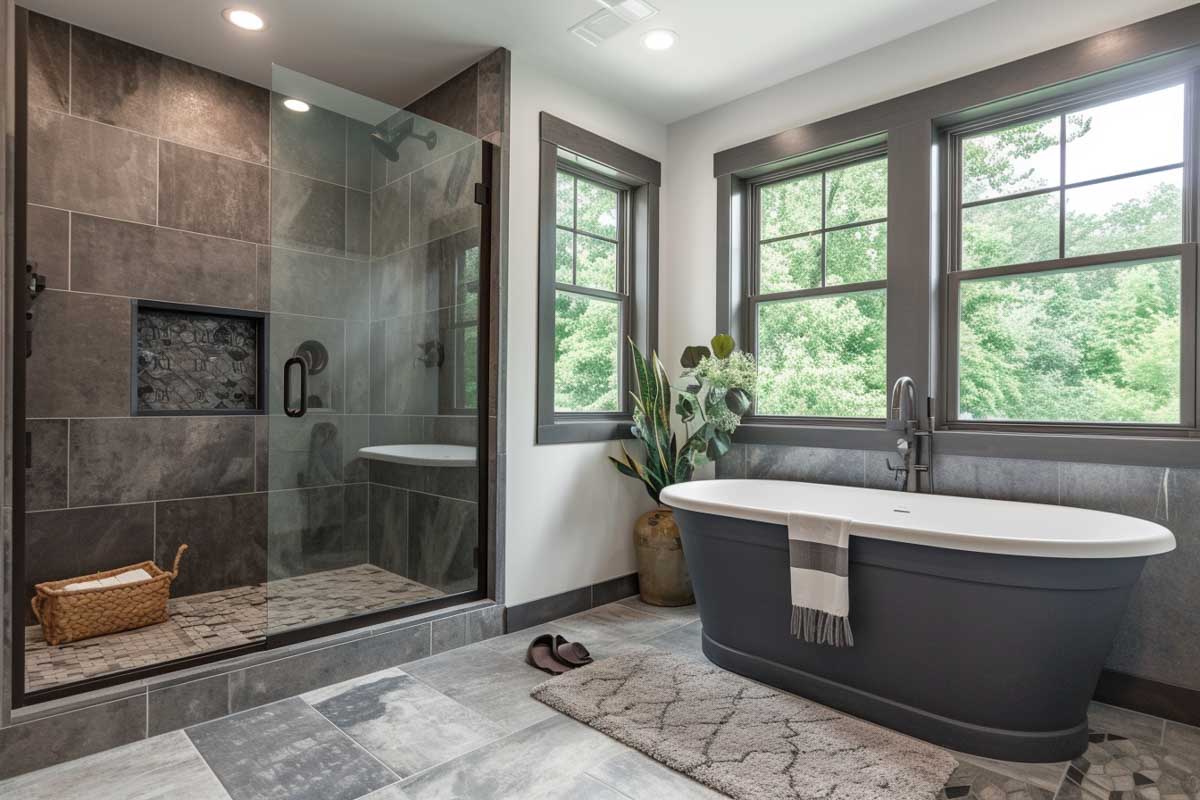
From classic farmhouses of soft, muted, and earthy tones to the more colorful Bohemian farmhouse style, there’s a farmhouse design that can suit your preferences.
The latest farmhouse color palette includes deep and natural greens as well as blues, with an option to add natural browns to the mix. Get tiles that simulate wooden textures if you want to simulate a shiplap finish.
Cool Coastal Farmhouse Colors: Soft whites, coral accents, and ocean blues are not the only colors you can pull together to create that coastal farmhouse shower. You can choose tiles with sandy beiges, seafoam greens, weathered grays, and crisp greens can also be added. A touch of soft yellows with simulated natural wood tones are also perfect accents for the color palette.
Bohemian Farmhouse Colors: Select colorful tiles such as Moroccan, Zellige, or glass tiles. Jewel-toned tiles are also perfect accents that can be layered with textured accessories in your farmhouse bathroom and enclosure.
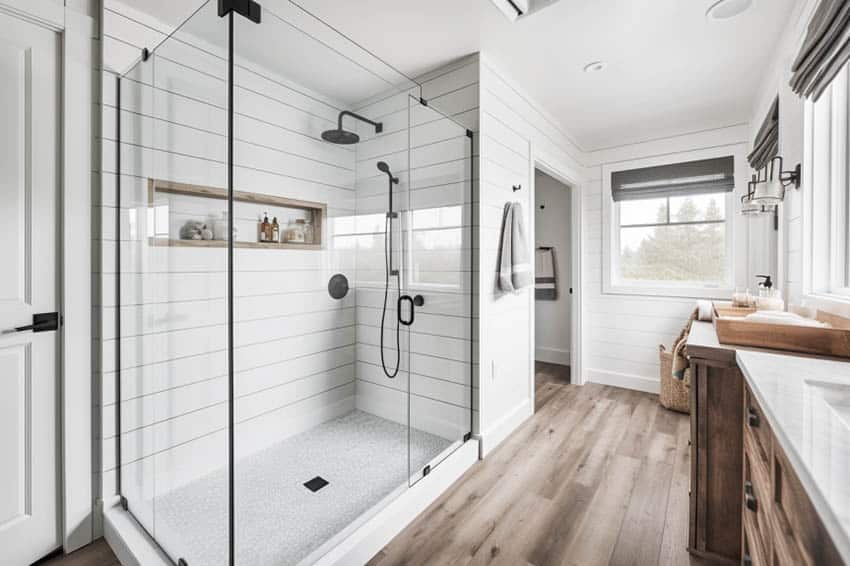
Industrial Farmhouse Colors: These range from neutral and brown tones that go well with matte black hardware. You can find tiles that simulate the look of exposed bricks or reclaimed wood. To complete the look, use industrial lighting fixtures. Match the finishes on the doors and enclosure fixtures with those on the vanity and sink faucets for a cohesive look.
French Country Farmhouse Colors: If you love patterned tiles for your farmhouse shower, the French Country Farmhouse Palette is a great option. You can have pastel tones such as lavender and light pink greens with your fern or floral patterns.
Maintenance and Cleaning
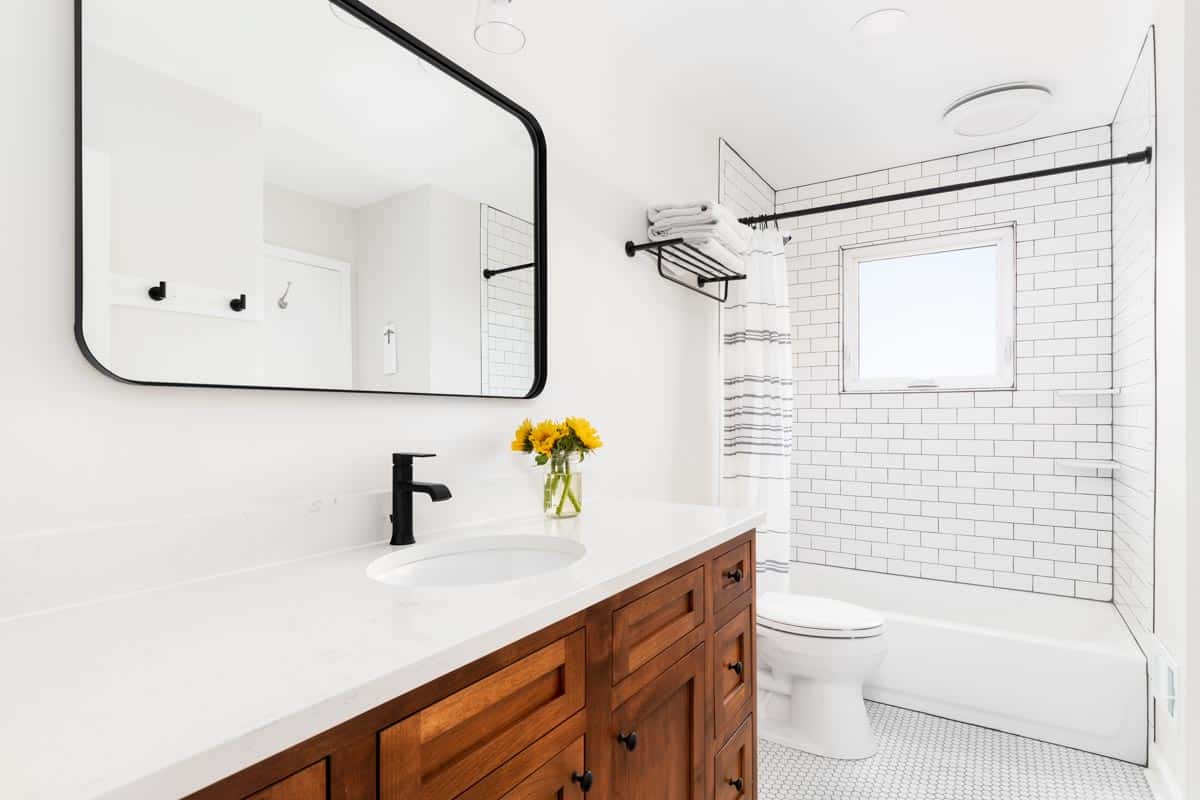
• Do Periodic Maintenance and Cleaning: Periodic cleaning is the best way to prevent damage and stubborn dirt and grime. Mineral deposits that may stay between grouts are the hardest to remove, so regular cleaning is the best way to maintain the pristine look of your shower tiles.
• Don’t use Harsh Solutions: Chemicals found in cleaning solutions can eat away sealant, grout, and even your tile material, so it is best to start with mild cleaners. If it’s stubborn dirt, you can try a section of your tile (discrete area such as the lower corner or edge of your tile layout) before applying it to the rest of the tiles.
• Don’t forget to Seal the Grout: Getting a quality sealer for your tile layout is the best way to prevent it from being damaged over time and ensure that no water or moisture will seep through the substrate. You may also need to reseal your tile grout after several months or years.
• Regular Wiping of Water: Hard water stains are common in shower areas due to their regular exposure to water and moisture. Wipe down your shower tiles regularly to prevent water stains. You can use vinegar and water solution or scrub down the hard water stains with a commercial descaler.



